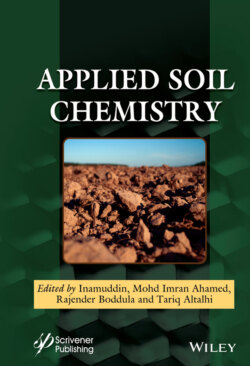Читать книгу Applied Soil Chemistry - Группа авторов - Страница 18
1.1.3 Cycle Time of Carbon in Soils
ОглавлениеDespite a global balance between carbon inflow from biological sources to a soil and CO2 output to the atmosphere through soil respiration, that process tends not to be a smooth sequential progression when observed locally in specific soils. On the contrary, carbon introduced in one seasonal cycle may take multiple seasonal and/or annual cycles before it is decayed step-by-step and ultimately becomes mineralized. The CO2 soil respiration output at any point in time comes cumulatively from organic material, at various stages of decay, introduced to the soil during multiple seasonal and annual cycles. The turnover time for carbon in soils varies significantly depending on its stage of maturity and can be determined precisely by carbon isotope dating (14C) techniques. For immature soils, rich in recently demised and introduced biological material, the turnover time is no more than 5 years and could be less than one year. For mineralized soil mixed with inorganic minerals, the turnover time is likely to amount to several decades. The most mature humified soils, from which there is very little carbon inflow and outflow, the carbon turnover times can be measured in thousands of years, meaning that they represent almost inert systems from the perspective of carbon flow [18].
It is often useful to establish turnover times for specific soils. In practice, individual soils will contain components and/or layers displaying a wide range of carbon turnover times. The turnover time of a particular soil layer tends to be influenced by the vegetative geographic zone which determines its sustained humidity and temperature and nutrient content. However, soil instability, due to impacts of extreme seasonal climatic swings and/ or severe weather events that can frequently disturb soils, for example, by increasing leaching rates by ground water, do substantially influence carbon turnover times in some cases.
He et al. (2016) [19] presented 14C dating measurements on 157 globally distributed soil profiles sampled to 1-m depth. Their results revealed that most existing Earth system models tended to substantially underestimate the mean age of carbon in all common soil types. Moreover, that underestimate was more than six-fold (430 ± 50 years versus 3,100 ± 1,800 years). This finding is not good news for soils as a potential carbon sequestration store, implying that models were making two-fold overestimates of soils global carbon sequestration capabilities. The results indicate that carbon stabilization is a slow process in many soils with long turnover times. This makes soils relative slow-to-develop and passive reservoirs, except on geological time scales, meaning that they cannot absorb large quantities of carbon over short periods of time. This limits soils potential to be a major part of a short-term carbon sequestration solution aimed at removing carbon from the atmosphere on a timescale of decades and over the duration of coming century, which is required to rapidly reverse rising carbon levels in the atmosphere.
The UN’s Intergovernmental Panel on Climate Change (van Diemen, 2019) [20], among other bodies (e.g., Halldorsson et al., 2015 [21]), had previously developed its models for carbon sequestration by soils assuming substantially shorter carbon cycling times. This erroneous assumption led the IPCC to suggest if deforestation on a global scale could be halted about 40 ppm of CO2, about 10% of current levels could be sequestered into soils from the atmosphere. It was believed that combined with major global changes in agricultural practices even more carbon could be absorbed by soils. There is now a more realistic recognition that the carbon absorption ability soils and their turnover periods for carbon cannot be substantially increased in the short-term from the prevailing slow rates [19].
